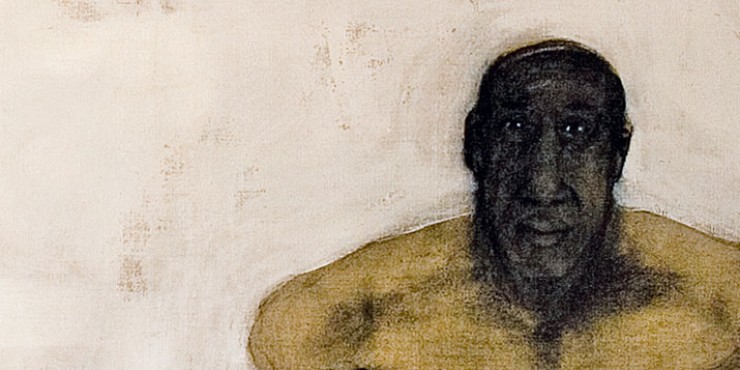
The conception of figurative painting as a form of pictorial expression was reevaluated and transformed throughout the whole twentieth century (with greater intensity in the last decades, ranging from Pop art and new figuration to different forms of Postmodernism) and even predictions about its disappearance (of painting as such) have not been well-founded, and thus figurative painting explores new forms of artistic language. The form and colour as real tools of expressive language emphasised through the figure its position in the overall structure of the picture.
The postmodernist wave, which subsided in the eighties, also influenced the work by Bahram Hajou in the early formative stage and to some extent inspired its development. His position as a person and artist was rather complicated. As an artist of Kurdish descent naturalised in Germany, he had to get accustomed to new living conditions, but it was more difficult for him to overcome social and cultural barriers and traps of living in isolation. However, his career, spanning more than twenty years, and his work document that he has been able to gain a new identity as a person and an artist without losing his authenticity.
The figure is an almost exclusive theme of his pictures although abstract and landscape paintings appear occasionally in various stages of his artistic development. The artist’s inner relationship to the figure and its expressive conception probably created a predisposition to openly accept and transform the stimuli of traditions of Western Modernism and Postmodernism in the expressionist line. In contrast to the styles exploring the figure, Bahram Hajou does not comply with a concrete order nor does he come under external influences, although he identifies himself with figuration. All that he does primarily manifests his own existence and conviction as a painter.
The artist perceives the figure as an expression of the essence of the drama of human life. However, this drama does not lie in dynamic movements, in extreme distortions of the body and limbs, or in explosive and spectacular imagery or in a precise transcription of real elements. The drama of his paintings emanates from the interior.
Although Bahram Hajou depicts partially reduced and deformed figures, he only does it as long as they enable him to express the intensity of expressive content. The influence of formal elements is strengthened by the inner context with philosophical ideas drawn on a number of areas and concepts (existentialism, psychology, freedom, communication and many others).
By choosing an almost monothematic focus on the figure, and on the method of its treatment, the artist opens one of the im/possibilities of seeking the path to dialogue. However, overcoming the differences between mental barriers is often a question of reconciliation.
Initially, Bahram Hajou was concerned with the sphere of subculture and people on the periphery of society, but the focus of his work has gradually shifted to the intimacy between man and woman. His pictures are composed of one to three figures, creating various relationships and forms of communication. They resonate with departures, loneliness, conflicts and vain endeavours to return and reconcile. The figures are captured in stiff movement as if taken by the camera and we gaze at them together with the artist. They depart from the pictures, turning their backs to the viewers, their heads bowed. His depictions of the face show expressive bright eyes and lips. The pictorial space is an important part of the existential atmosphere. His pictures are mostly depicted against a grey background emphasising departure to the void, the loss of real position data for the non/existence of being. The colour forms a complex of elements creating a distinctive character of his artistic expression. The artist works with an exceptional feeling for painting, using the nuances of grey, grey-white, white and black, frequently enhancing them by drawing. He uses blue, red and green as local accents, balancing the composition of the picture and producing a psychological effect.
The pictures by Bahram Hajou capture the viewer’s attention at first sight by their immensely convincing power of expression and inner strength. His painting is about a multitude in simplicity, about the rich inner emotional world of a lonely individual, about isolation and alienation, but also about a desire for love and understanding. The work by Bahram Hajou is an outstanding example of the penetration of various cultural, ethnic, social and worldview differences into new contexts of the multicultural symbiosis.




